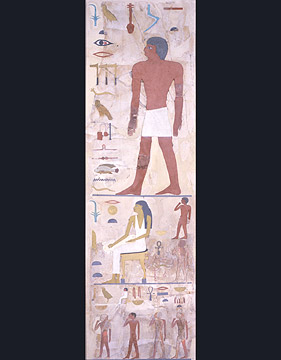Image Resource Bank
Image Gallery |  10 of 15
10 of 15 
Panel from the Tomb of Nefermaat and Itet
On this limestone panel from the tomb of Itet and her husband Nefermaat both the inscriptions and the images of the individuals are, unusually, done by using inlaid colored paste rather than carving and/or painting. The inscription in front of Nefermaat brags, "He is one who made his gods in writing that cannot be erased."
In this case the word translated “gods” is referring to the hieroglyphic inscription itself, because writing was given to mankind by the gods.
The rules of decorum require that the husband, probably the son of King Huni and half-brother of King Snefru, be given prominence and shown on a larger scale even in the wife’s tomb chamber. The elite status of Itet herself is indicated by her sitting on a fancy stool with bull’s legs. Note also that Itet is shown having light yellow brown skin while her husband and the young boys (presumably sons and/or grandsons) are shown with dark reddish brown complexions. Note also that the boys are shown naked and with their finger pointing to their mouths, both indicators of childhood.
Name: Panel from the Tomb of Nefermaat and Itet
Material: Limestone, colored paste
Size:
Height: 3 m (9 ft 10 in)
Width: 1 m (3 ft)
Depth: 7.62 cm (3 in)
Date: c. 2639 BCE, Old Kingdom, late Dynasty 3-Early Dynasty 4, reigns of Huni and Snefru
Place of Origin: Medum, Egypt
Location: Oriental Institute Museum, Chicago, Illinois
Source, Registration#, and Publication: Oriental Institute Museum, 9002. Teeter, Emily, Treasures from the Collection of the Oriental Institute, Chicago: The Oriental Institute of the University of Chicago, 2003. p. 15

 Janet H. Johnson
Janet H. Johnson
Morton D. Hull Distinguished Service Professor of Egyptology




